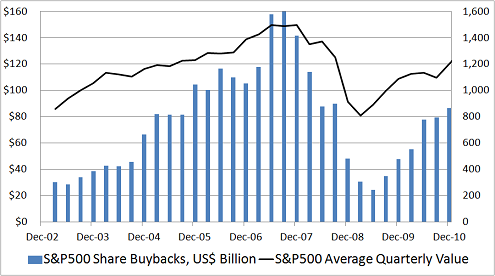Atmos Energy: Creating or Destroying Shareholder Value?

I'm highly skeptical about the economic value of most share repurchase programs. To see why, look at the following graph of the total buyback dollar amount for the companies in the S&P 500, compared with the average price of the index on a quarterly basis:
Source: Standard & Poor's.
Source: Standard & Poor's.
Source: Standard & Poor's.
Share buybacks for the S&P 500 accelerated in the second half of 2004, culminating in a sharp spike during the first two quarters of 2007 -- just as the stock market was peaking. Conversely, when stocks traded at bargain prices during the worst of the crisis, share buybacks dried up. Then, as stocks became more expensive during the rally that began in March 2009, companies once more became happy to step up the dollar amounts spent on share repurchases.
Still, not all buyback programs hurt shareholders. To praise smart capital allocators and shame those who fritter away shareholder capital, I've decided to track individual share-repurchase programs. Today, I'm looking at the new program established by gas utility Atmos Energy (NYS: ATO) .
How much, for how long?
The new share repurchase program has a five-year time window and allows for the purchase of up to 5 million shares.
How cheap is the stock?
Atmos Energy's announcement doesn't specifically mention the share price as one of the factors that will determine the company's ability to spend its authorization. Unusually, the program is formulated in terms of a target number of shares instead of a dollar amount allocated toward repurchases. There's a reason for that: The company states openly that its primary objective is to offset the dilutive effect of compensation-related equity grants. That's a huge red flag, as it suggests that management lacks proper incentives and regard for shareholders.
It's the relationship between price paid and intrinsic value that will determine whether the share repurchases are compounding or destroying shareholder wealth, not the number of shares outstanding. Just how cheap (or expensive) are the shares right now? Based on its price-to-earnings multiple, Atmos Energy is cheaper than four of its peers:
Company | Forward P/E |
|---|---|
ONEOK (NYS: OKE) | 20.0 |
National Fuel Gas (NYS: NFG) | 17.0 |
WGL Holdings (NYS: WGL) | 16.8 |
El Paso (NYS: EP) | 15.4 |
Atmos Energy (NYS: ATO) | 13.3 |
Source: Capital IQ, a division of Standard & Poor's.
Is this a smart use of shareholder capital?
Atmos Energy's price-to-earnings multiple is in the bottom quintile relative to its industry peers, and in the middle of the range relative to all companies in the S&P 500 and to its own five-year history. With shares trading at 13.3 times its earnings-per-share estimate for the next 12 months, the new share-buyback authorization looks like a poor use of shareholder capital at these prices.
At the time thisarticle was published Fool contributorAlex Dumortierholds no position in any company mentioned. Check out hisholdings and a short bio. You can follow himon Twitter. The Motley Fool owns shares of El Paso.Motley Fool newsletter serviceshave recommended buying shares of ONEOK. Try any of our Foolish newsletter servicesfree for 30 days. We Fools don't all hold the same opinions, but we all believe thatconsidering a diverse range of insightsmakes us better investors. The Motley Fool has adisclosure policy.
Copyright © 1995 - 2011 The Motley Fool, LLC. All rights reserved. The Motley Fool has a disclosure policy.

